Data Analysis Report: Statistical Analysis and Linear Forecasting
VerifiedAdded on 2023/06/09
|11
|1407
|395
Report
AI Summary
This report provides a comprehensive analysis of a given dataset, starting with its arrangement in a tabular format and its visualization using column and line charts. It then delves into calculating various statistical measures such as mean, mode, median, range, and standard deviation to understand the data's central tendencies and dispersion. A linear forecasting model (y = mx + c) is applied to predict future values for the 11th and 12th days. The report concludes that statistical analysis is crucial for firms across all sectors, aiding in the evaluation of factors affecting total amounts and enabling the implementation of necessary actions. Furthermore, the computations performed are essential for measuring the business's true financial positioning.
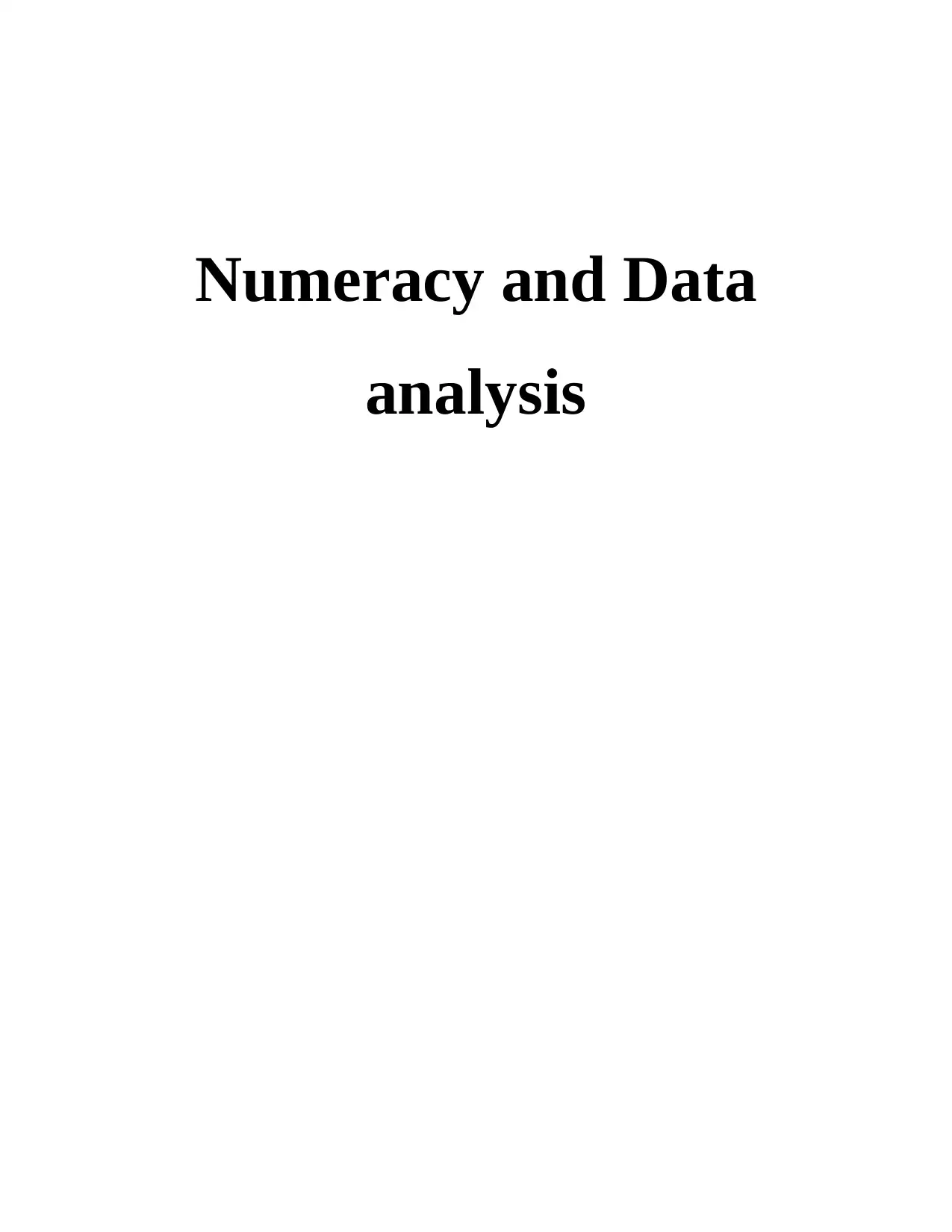
Numeracy and Data
analysis
analysis
Paraphrase This Document
Need a fresh take? Get an instant paraphrase of this document with our AI Paraphraser

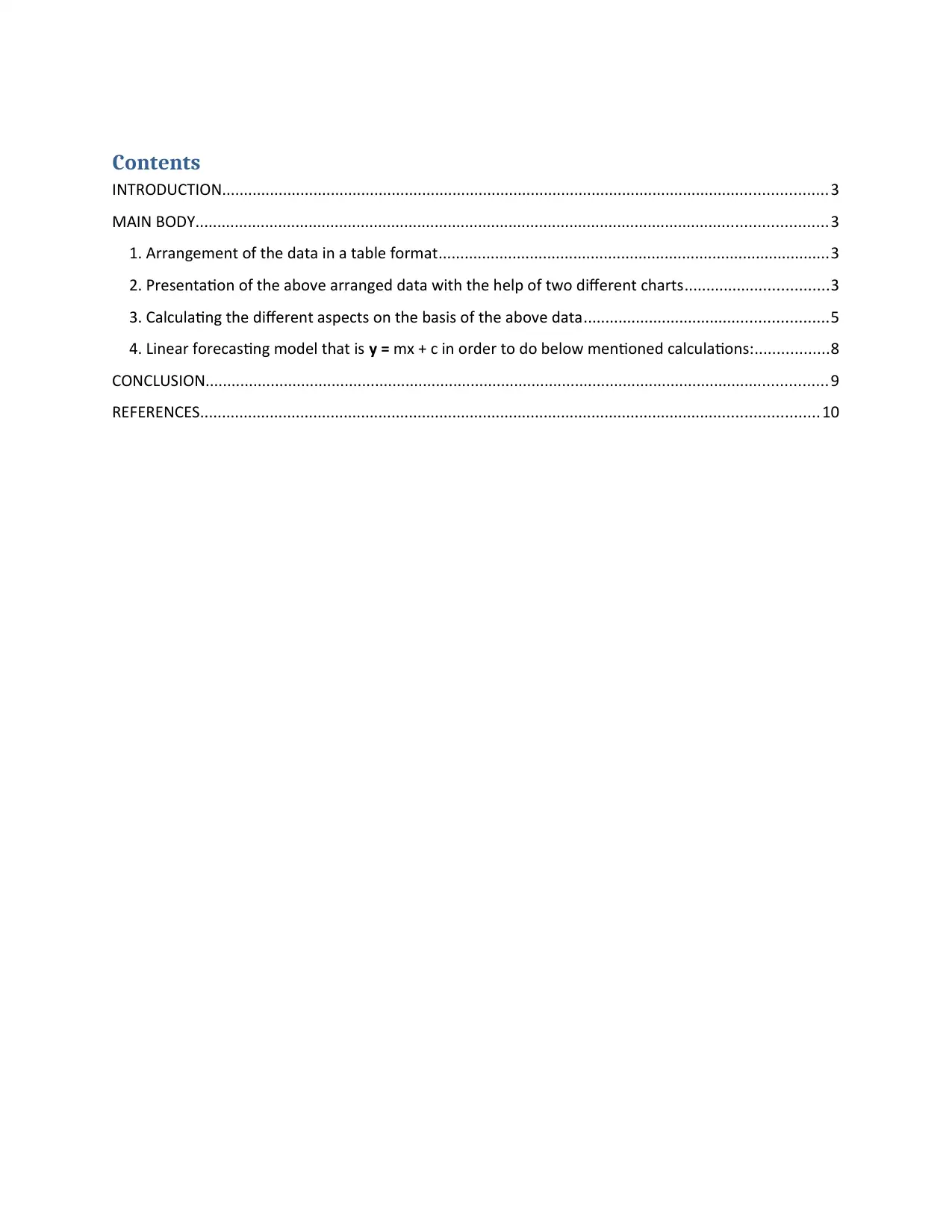
Contents
INTRODUCTION...........................................................................................................................................3
MAIN BODY.................................................................................................................................................3
1. Arrangement of the data in a table format..........................................................................................3
2. Presentation of the above arranged data with the help of two different charts.................................3
3. Calculating the different aspects on the basis of the above data........................................................5
4. Linear forecasting model that is y = mx + c in order to do below mentioned calculations:.................8
CONCLUSION...............................................................................................................................................9
REFERENCES..............................................................................................................................................10
INTRODUCTION...........................................................................................................................................3
MAIN BODY.................................................................................................................................................3
1. Arrangement of the data in a table format..........................................................................................3
2. Presentation of the above arranged data with the help of two different charts.................................3
3. Calculating the different aspects on the basis of the above data........................................................5
4. Linear forecasting model that is y = mx + c in order to do below mentioned calculations:.................8
CONCLUSION...............................................................................................................................................9
REFERENCES..............................................................................................................................................10
⊘ This is a preview!⊘
Do you want full access?
Subscribe today to unlock all pages.

Trusted by 1+ million students worldwide
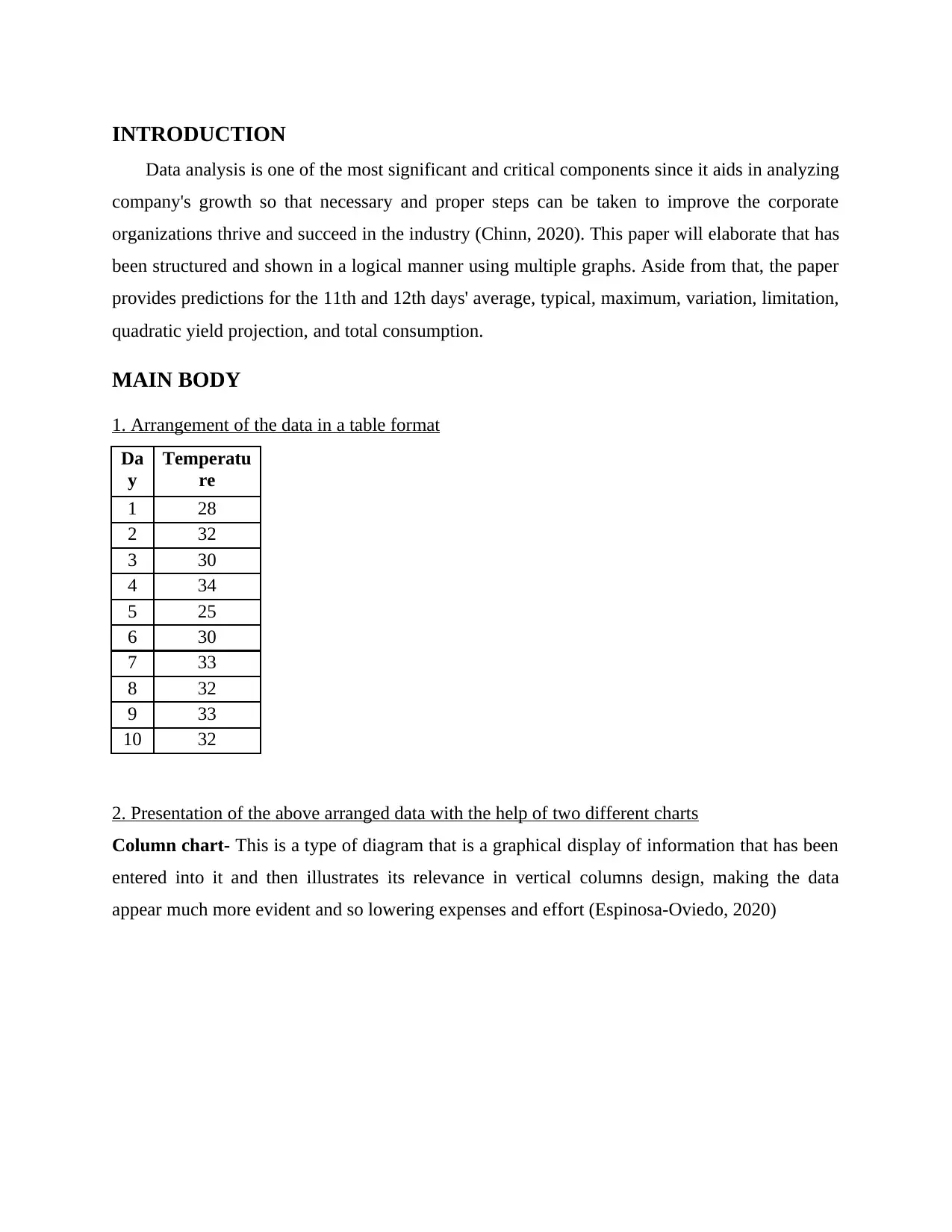
INTRODUCTION
Data analysis is one of the most significant and critical components since it aids in analyzing
company's growth so that necessary and proper steps can be taken to improve the corporate
organizations thrive and succeed in the industry (Chinn, 2020). This paper will elaborate that has
been structured and shown in a logical manner using multiple graphs. Aside from that, the paper
provides predictions for the 11th and 12th days' average, typical, maximum, variation, limitation,
quadratic yield projection, and total consumption.
MAIN BODY
1. Arrangement of the data in a table format
Da
y
Temperatu
re
1 28
2 32
3 30
4 34
5 25
6 30
7 33
8 32
9 33
10 32
2. Presentation of the above arranged data with the help of two different charts
Column chart- This is a type of diagram that is a graphical display of information that has been
entered into it and then illustrates its relevance in vertical columns design, making the data
appear much more evident and so lowering expenses and effort (Espinosa-Oviedo, 2020)
Data analysis is one of the most significant and critical components since it aids in analyzing
company's growth so that necessary and proper steps can be taken to improve the corporate
organizations thrive and succeed in the industry (Chinn, 2020). This paper will elaborate that has
been structured and shown in a logical manner using multiple graphs. Aside from that, the paper
provides predictions for the 11th and 12th days' average, typical, maximum, variation, limitation,
quadratic yield projection, and total consumption.
MAIN BODY
1. Arrangement of the data in a table format
Da
y
Temperatu
re
1 28
2 32
3 30
4 34
5 25
6 30
7 33
8 32
9 33
10 32
2. Presentation of the above arranged data with the help of two different charts
Column chart- This is a type of diagram that is a graphical display of information that has been
entered into it and then illustrates its relevance in vertical columns design, making the data
appear much more evident and so lowering expenses and effort (Espinosa-Oviedo, 2020)
Paraphrase This Document
Need a fresh take? Get an instant paraphrase of this document with our AI Paraphraser
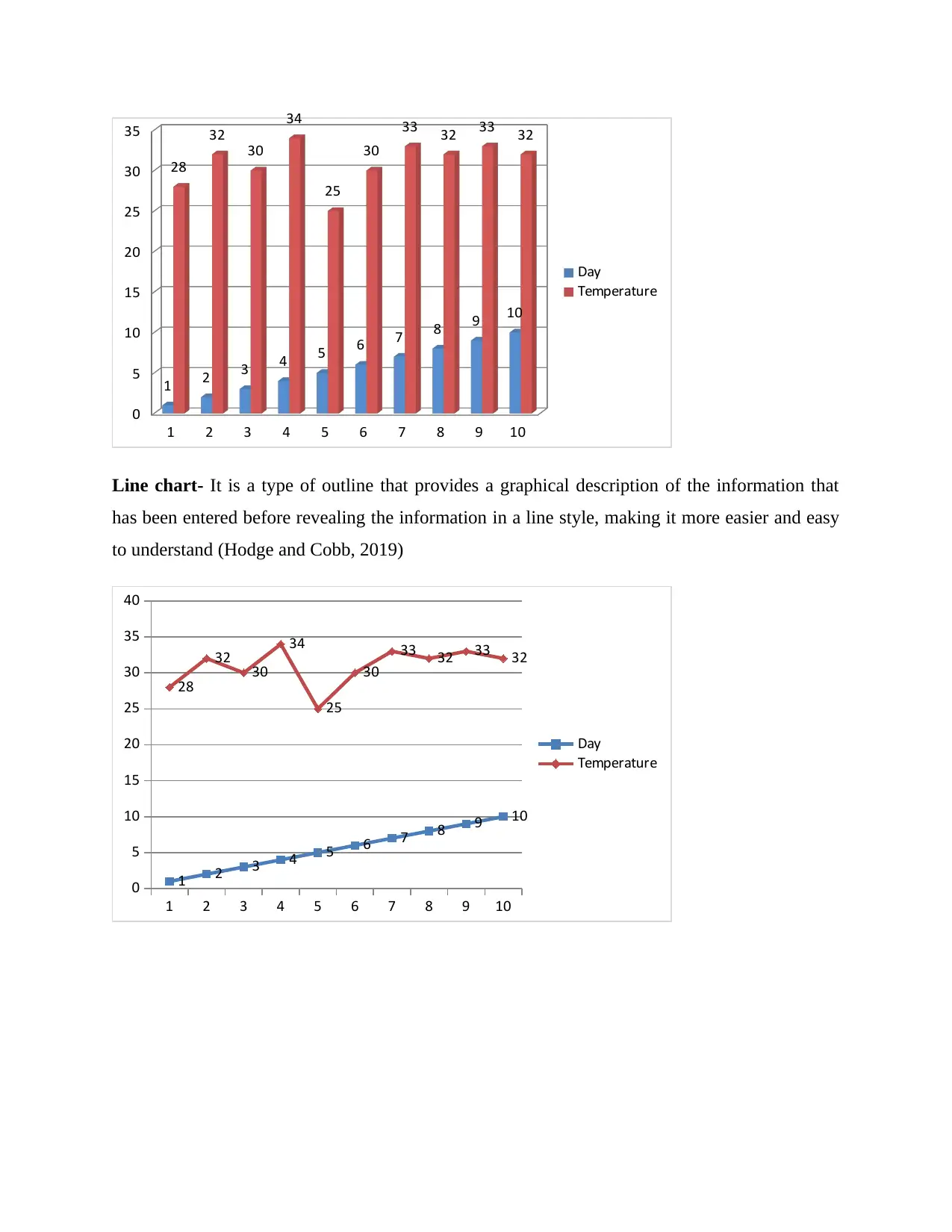
1 2 3 4 5 6 7 8 9 10
0
5
10
15
20
25
30
35
1 2 3 4 5 6 7 8 9 10
28
32
30
34
25
30
33 32 33 32
Day
Temperature
Line chart- It is a type of outline that provides a graphical description of the information that
has been entered before revealing the information in a line style, making it more easier and easy
to understand (Hodge and Cobb, 2019)
1 2 3 4 5 6 7 8 9 10
0
5
10
15
20
25
30
35
40
1 2 3 4 5 6 7 8 9 10
28
32 30
34
25
30
33 32 33 32
Day
Temperature
0
5
10
15
20
25
30
35
1 2 3 4 5 6 7 8 9 10
28
32
30
34
25
30
33 32 33 32
Day
Temperature
Line chart- It is a type of outline that provides a graphical description of the information that
has been entered before revealing the information in a line style, making it more easier and easy
to understand (Hodge and Cobb, 2019)
1 2 3 4 5 6 7 8 9 10
0
5
10
15
20
25
30
35
40
1 2 3 4 5 6 7 8 9 10
28
32 30
34
25
30
33 32 33 32
Day
Temperature
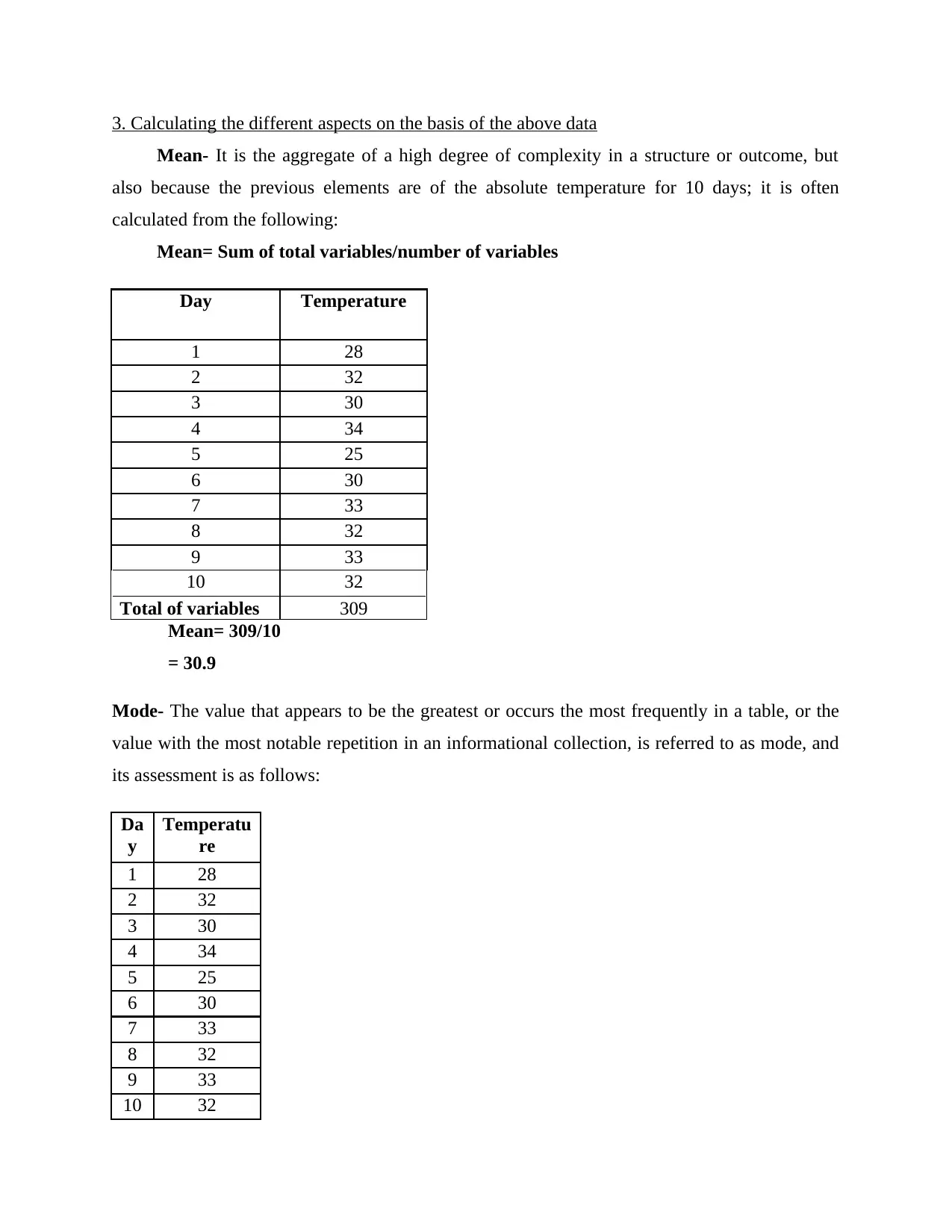
3. Calculating the different aspects on the basis of the above data
Mean- It is the aggregate of a high degree of complexity in a structure or outcome, but
also because the previous elements are of the absolute temperature for 10 days; it is often
calculated from the following:
Mean= Sum of total variables/number of variables
Day Temperature
1 28
2 32
3 30
4 34
5 25
6 30
7 33
8 32
9 33
10 32
Total of variables 309
Mean= 309/10
= 30.9
Mode- The value that appears to be the greatest or occurs the most frequently in a table, or the
value with the most notable repetition in an informational collection, is referred to as mode, and
its assessment is as follows:
Da
y
Temperatu
re
1 28
2 32
3 30
4 34
5 25
6 30
7 33
8 32
9 33
10 32
Mean- It is the aggregate of a high degree of complexity in a structure or outcome, but
also because the previous elements are of the absolute temperature for 10 days; it is often
calculated from the following:
Mean= Sum of total variables/number of variables
Day Temperature
1 28
2 32
3 30
4 34
5 25
6 30
7 33
8 32
9 33
10 32
Total of variables 309
Mean= 309/10
= 30.9
Mode- The value that appears to be the greatest or occurs the most frequently in a table, or the
value with the most notable repetition in an informational collection, is referred to as mode, and
its assessment is as follows:
Da
y
Temperatu
re
1 28
2 32
3 30
4 34
5 25
6 30
7 33
8 32
9 33
10 32
⊘ This is a preview!⊘
Do you want full access?
Subscribe today to unlock all pages.

Trusted by 1+ million students worldwide
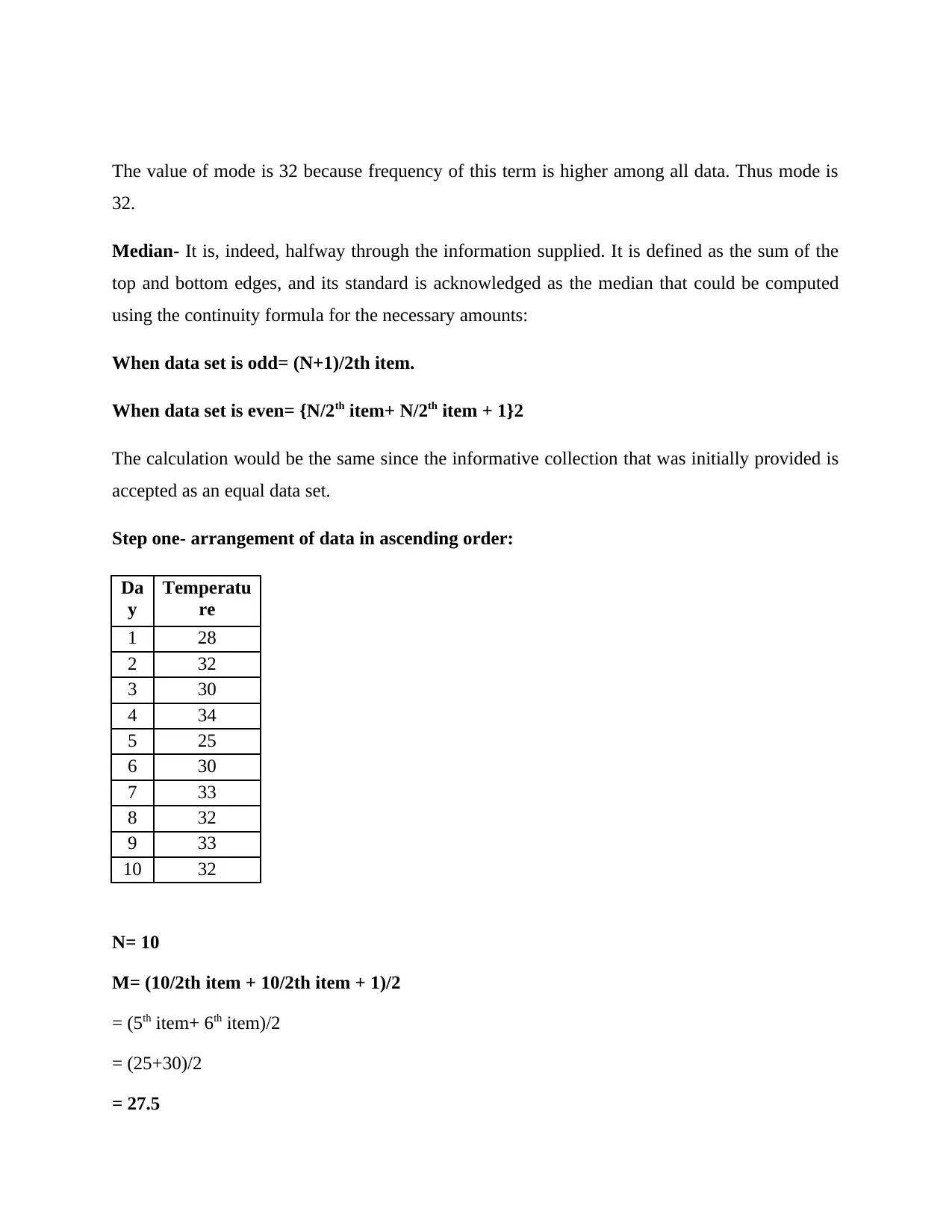
The value of mode is 32 because frequency of this term is higher among all data. Thus mode is
32.
Median- It is, indeed, halfway through the information supplied. It is defined as the sum of the
top and bottom edges, and its standard is acknowledged as the median that could be computed
using the continuity formula for the necessary amounts:
When data set is odd= (N+1)/2th item.
When data set is even= {N/2th item+ N/2th item + 1}2
The calculation would be the same since the informative collection that was initially provided is
accepted as an equal data set.
Step one- arrangement of data in ascending order:
Da
y
Temperatu
re
1 28
2 32
3 30
4 34
5 25
6 30
7 33
8 32
9 33
10 32
N= 10
M= (10/2th item + 10/2th item + 1)/2
= (5th item+ 6th item)/2
= (25+30)/2
= 27.5
32.
Median- It is, indeed, halfway through the information supplied. It is defined as the sum of the
top and bottom edges, and its standard is acknowledged as the median that could be computed
using the continuity formula for the necessary amounts:
When data set is odd= (N+1)/2th item.
When data set is even= {N/2th item+ N/2th item + 1}2
The calculation would be the same since the informative collection that was initially provided is
accepted as an equal data set.
Step one- arrangement of data in ascending order:
Da
y
Temperatu
re
1 28
2 32
3 30
4 34
5 25
6 30
7 33
8 32
9 33
10 32
N= 10
M= (10/2th item + 10/2th item + 1)/2
= (5th item+ 6th item)/2
= (25+30)/2
= 27.5
Paraphrase This Document
Need a fresh take? Get an instant paraphrase of this document with our AI Paraphraser
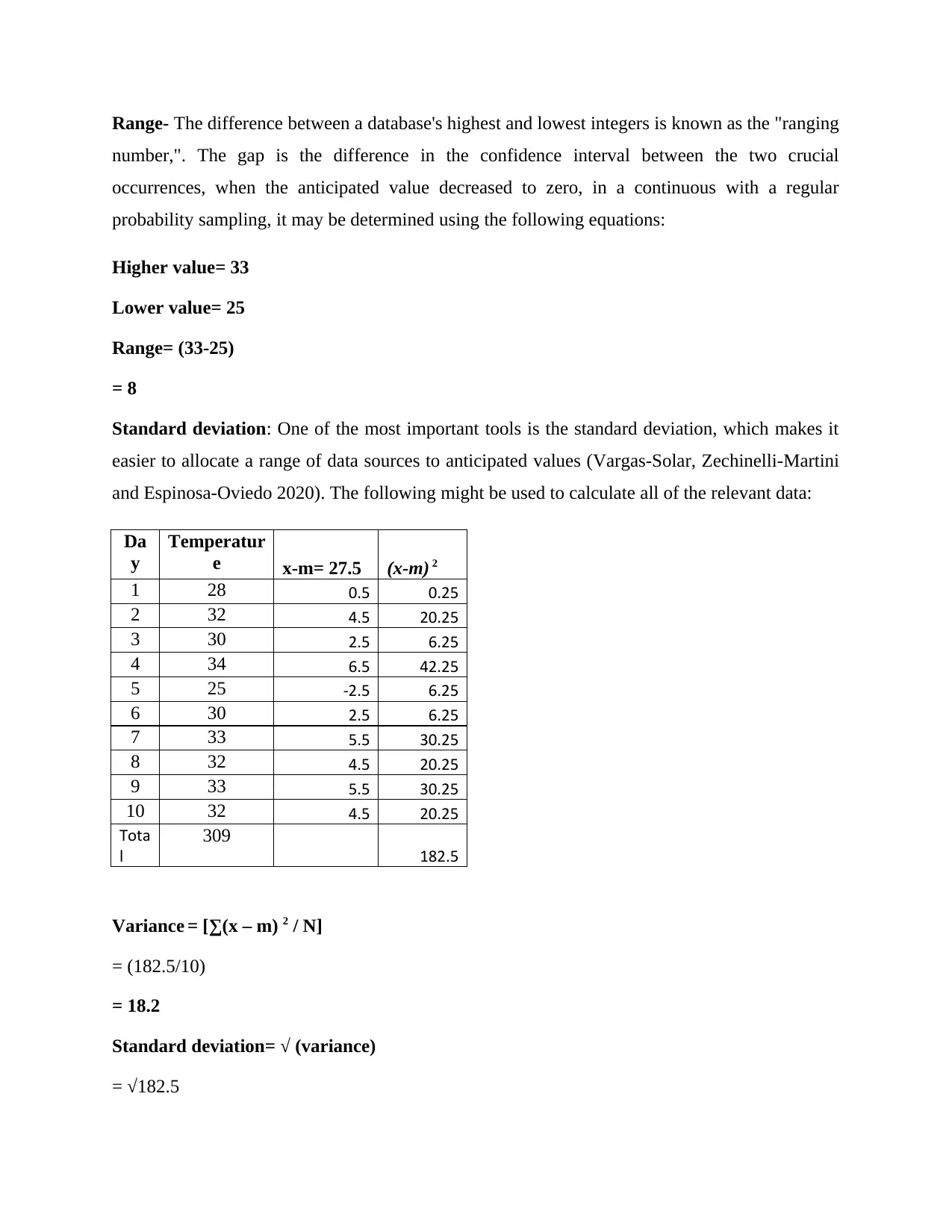
Range- The difference between a database's highest and lowest integers is known as the "ranging
number,". The gap is the difference in the confidence interval between the two crucial
occurrences, when the anticipated value decreased to zero, in a continuous with a regular
probability sampling, it may be determined using the following equations:
Higher value= 33
Lower value= 25
Range= (33-25)
= 8
Standard deviation: One of the most important tools is the standard deviation, which makes it
easier to allocate a range of data sources to anticipated values (Vargas-Solar, Zechinelli-Martini
and Espinosa-Oviedo 2020). The following might be used to calculate all of the relevant data:
Da
y
Temperatur
e x-m= 27.5 (x-m) 2
1 28 0.5 0.25
2 32 4.5 20.25
3 30 2.5 6.25
4 34 6.5 42.25
5 25 -2.5 6.25
6 30 2.5 6.25
7 33 5.5 30.25
8 32 4.5 20.25
9 33 5.5 30.25
10 32 4.5 20.25
Tota
l
309
182.5
Variance = [∑(x – m) 2 / N]
= (182.5/10)
= 18.2
Standard deviation= √ (variance)
= √182.5
number,". The gap is the difference in the confidence interval between the two crucial
occurrences, when the anticipated value decreased to zero, in a continuous with a regular
probability sampling, it may be determined using the following equations:
Higher value= 33
Lower value= 25
Range= (33-25)
= 8
Standard deviation: One of the most important tools is the standard deviation, which makes it
easier to allocate a range of data sources to anticipated values (Vargas-Solar, Zechinelli-Martini
and Espinosa-Oviedo 2020). The following might be used to calculate all of the relevant data:
Da
y
Temperatur
e x-m= 27.5 (x-m) 2
1 28 0.5 0.25
2 32 4.5 20.25
3 30 2.5 6.25
4 34 6.5 42.25
5 25 -2.5 6.25
6 30 2.5 6.25
7 33 5.5 30.25
8 32 4.5 20.25
9 33 5.5 30.25
10 32 4.5 20.25
Tota
l
309
182.5
Variance = [∑(x – m) 2 / N]
= (182.5/10)
= 18.2
Standard deviation= √ (variance)
= √182.5
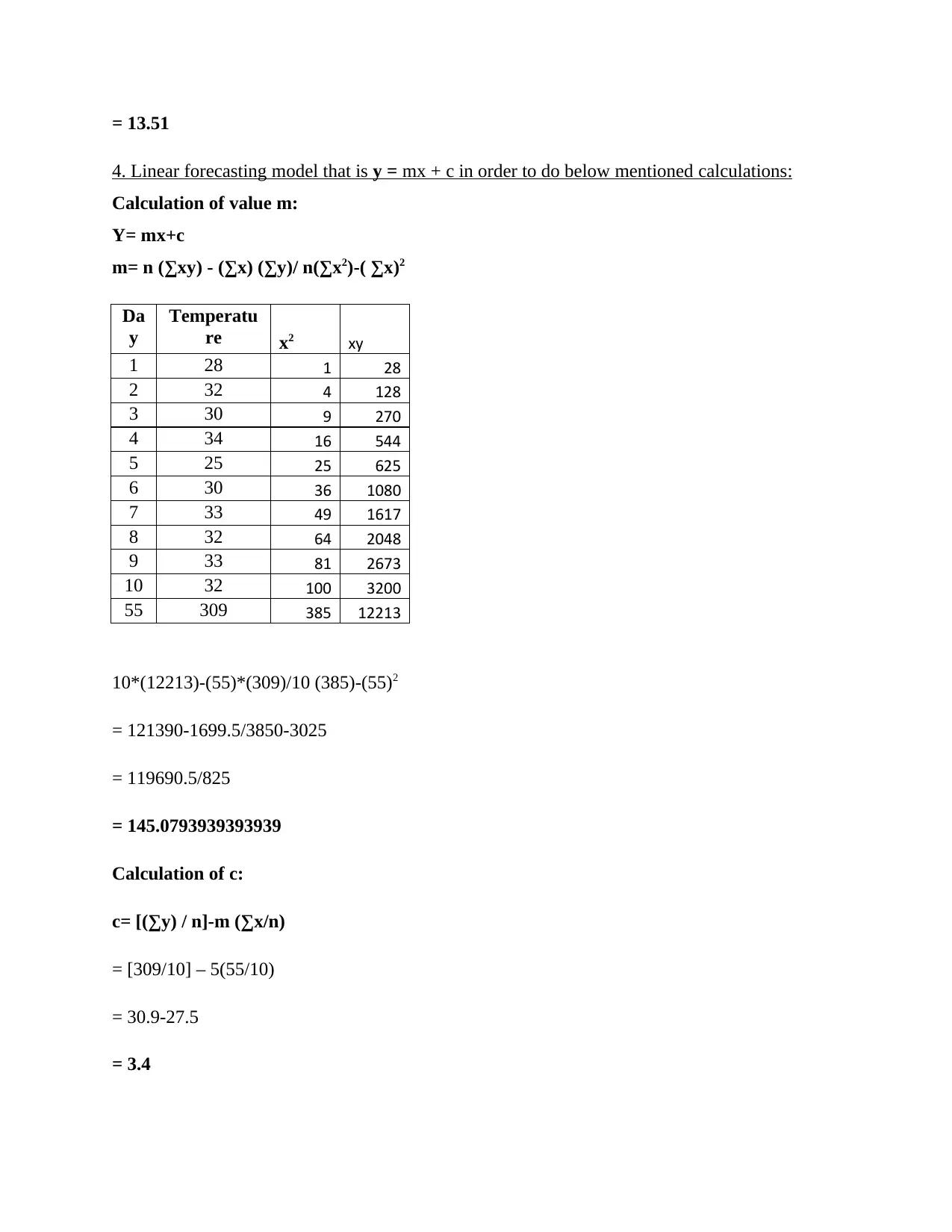
= 13.51
4. Linear forecasting model that is y = mx + c in order to do below mentioned calculations:
Calculation of value m:
Y= mx+c
m= n (∑xy) - (∑x) (∑y)/ n(∑x2)-( ∑x)2
Da
y
Temperatu
re x2 xy
1 28 1 28
2 32 4 128
3 30 9 270
4 34 16 544
5 25 25 625
6 30 36 1080
7 33 49 1617
8 32 64 2048
9 33 81 2673
10 32 100 3200
55 309 385 12213
10*(12213)-(55)*(309)/10 (385)-(55)2
= 121390-1699.5/3850-3025
= 119690.5/825
= 145.0793939393939
Calculation of c:
c= [(∑y) / n]-m (∑x/n)
= [309/10] – 5(55/10)
= 30.9-27.5
= 3.4
4. Linear forecasting model that is y = mx + c in order to do below mentioned calculations:
Calculation of value m:
Y= mx+c
m= n (∑xy) - (∑x) (∑y)/ n(∑x2)-( ∑x)2
Da
y
Temperatu
re x2 xy
1 28 1 28
2 32 4 128
3 30 9 270
4 34 16 544
5 25 25 625
6 30 36 1080
7 33 49 1617
8 32 64 2048
9 33 81 2673
10 32 100 3200
55 309 385 12213
10*(12213)-(55)*(309)/10 (385)-(55)2
= 121390-1699.5/3850-3025
= 119690.5/825
= 145.0793939393939
Calculation of c:
c= [(∑y) / n]-m (∑x/n)
= [309/10] – 5(55/10)
= 30.9-27.5
= 3.4
⊘ This is a preview!⊘
Do you want full access?
Subscribe today to unlock all pages.

Trusted by 1+ million students worldwide
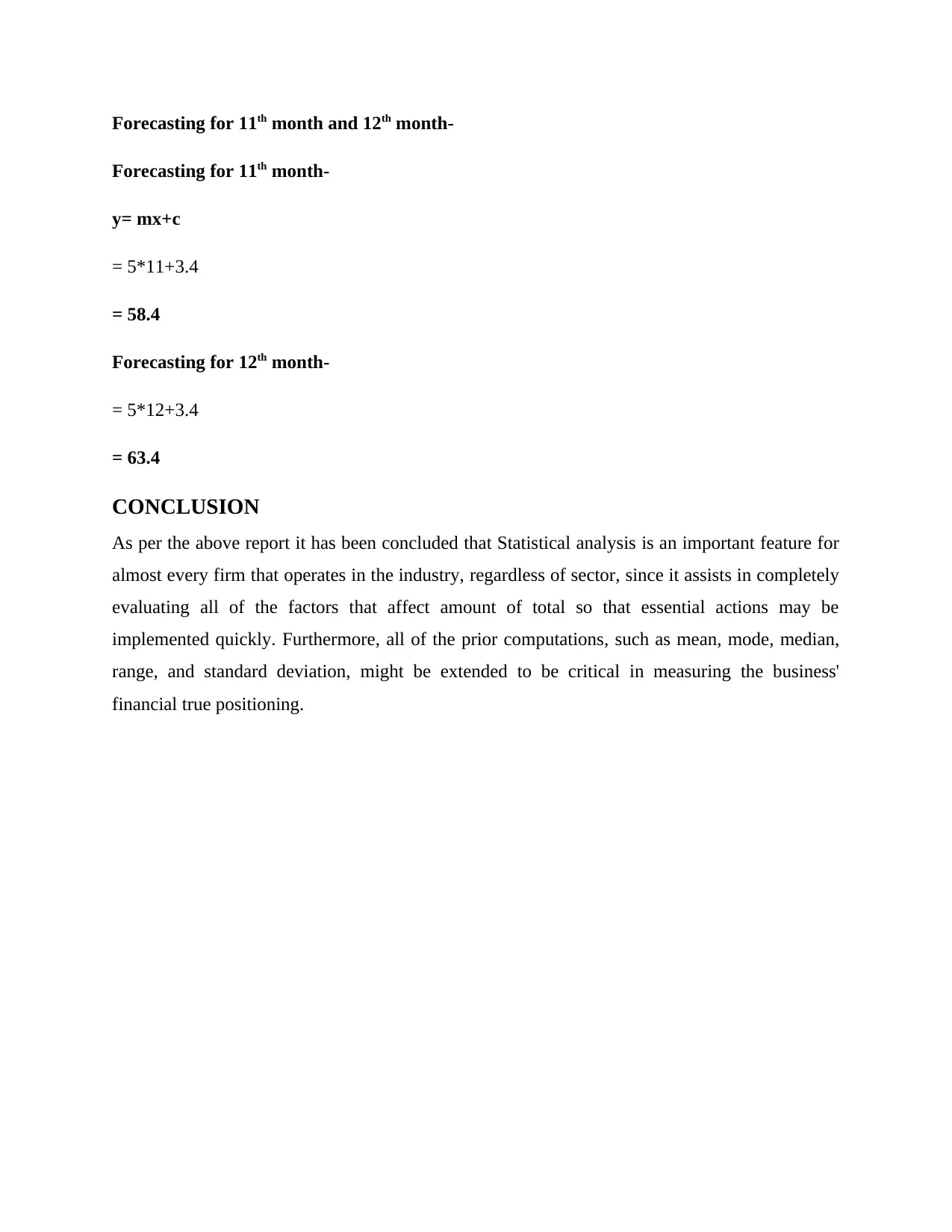
Forecasting for 11th month and 12th month-
Forecasting for 11th month-
y= mx+c
= 5*11+3.4
= 58.4
Forecasting for 12th month-
= 5*12+3.4
= 63.4
CONCLUSION
As per the above report it has been concluded that Statistical analysis is an important feature for
almost every firm that operates in the industry, regardless of sector, since it assists in completely
evaluating all of the factors that affect amount of total so that essential actions may be
implemented quickly. Furthermore, all of the prior computations, such as mean, mode, median,
range, and standard deviation, might be extended to be critical in measuring the business'
financial true positioning.
Forecasting for 11th month-
y= mx+c
= 5*11+3.4
= 58.4
Forecasting for 12th month-
= 5*12+3.4
= 63.4
CONCLUSION
As per the above report it has been concluded that Statistical analysis is an important feature for
almost every firm that operates in the industry, regardless of sector, since it assists in completely
evaluating all of the factors that affect amount of total so that essential actions may be
implemented quickly. Furthermore, all of the prior computations, such as mean, mode, median,
range, and standard deviation, might be extended to be critical in measuring the business'
financial true positioning.
Paraphrase This Document
Need a fresh take? Get an instant paraphrase of this document with our AI Paraphraser
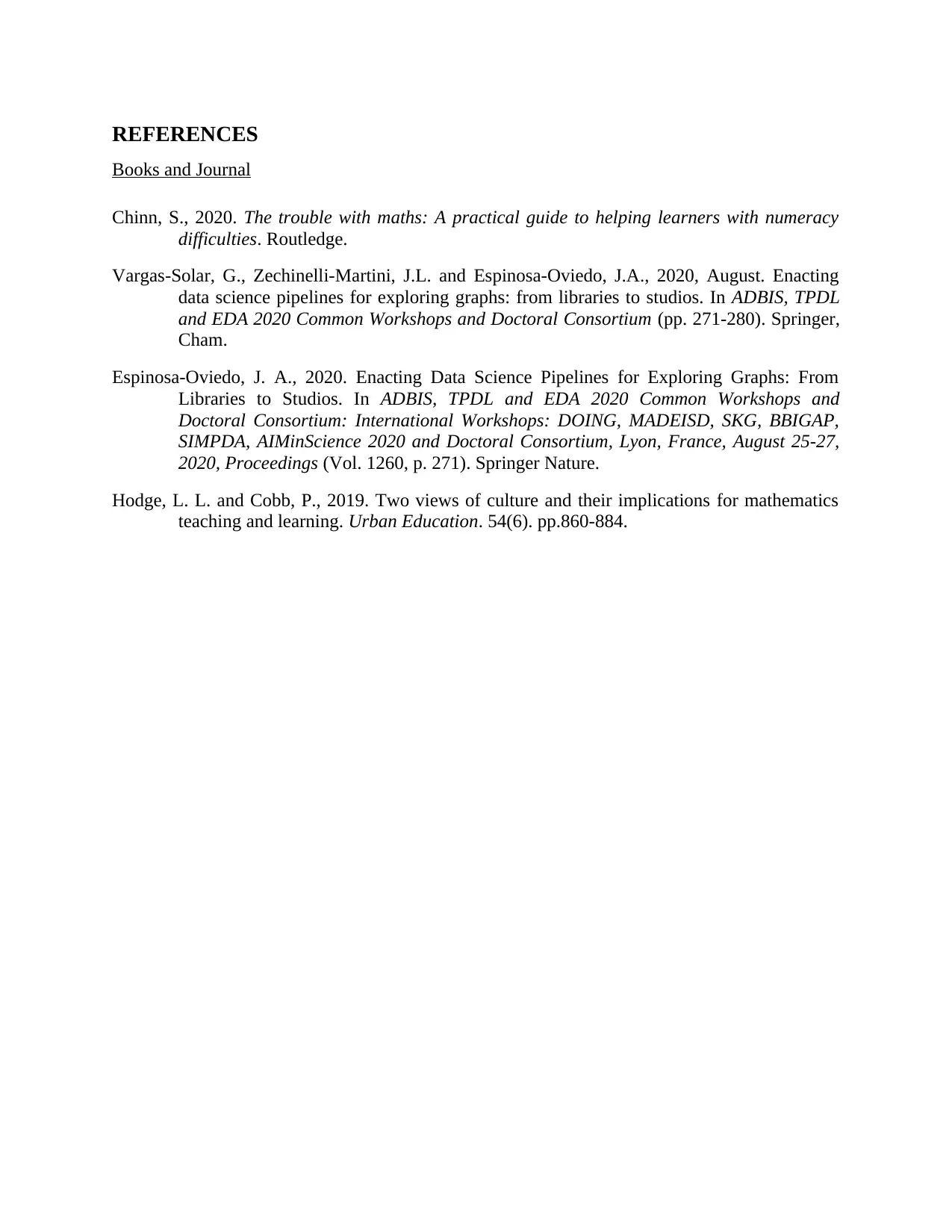
REFERENCES
Books and Journal
Chinn, S., 2020. The trouble with maths: A practical guide to helping learners with numeracy
difficulties. Routledge.
Vargas-Solar, G., Zechinelli-Martini, J.L. and Espinosa-Oviedo, J.A., 2020, August. Enacting
data science pipelines for exploring graphs: from libraries to studios. In ADBIS, TPDL
and EDA 2020 Common Workshops and Doctoral Consortium (pp. 271-280). Springer,
Cham.
Espinosa-Oviedo, J. A., 2020. Enacting Data Science Pipelines for Exploring Graphs: From
Libraries to Studios. In ADBIS, TPDL and EDA 2020 Common Workshops and
Doctoral Consortium: International Workshops: DOING, MADEISD, SKG, BBIGAP,
SIMPDA, AIMinScience 2020 and Doctoral Consortium, Lyon, France, August 25-27,
2020, Proceedings (Vol. 1260, p. 271). Springer Nature.
Hodge, L. L. and Cobb, P., 2019. Two views of culture and their implications for mathematics
teaching and learning. Urban Education. 54(6). pp.860-884.
Books and Journal
Chinn, S., 2020. The trouble with maths: A practical guide to helping learners with numeracy
difficulties. Routledge.
Vargas-Solar, G., Zechinelli-Martini, J.L. and Espinosa-Oviedo, J.A., 2020, August. Enacting
data science pipelines for exploring graphs: from libraries to studios. In ADBIS, TPDL
and EDA 2020 Common Workshops and Doctoral Consortium (pp. 271-280). Springer,
Cham.
Espinosa-Oviedo, J. A., 2020. Enacting Data Science Pipelines for Exploring Graphs: From
Libraries to Studios. In ADBIS, TPDL and EDA 2020 Common Workshops and
Doctoral Consortium: International Workshops: DOING, MADEISD, SKG, BBIGAP,
SIMPDA, AIMinScience 2020 and Doctoral Consortium, Lyon, France, August 25-27,
2020, Proceedings (Vol. 1260, p. 271). Springer Nature.
Hodge, L. L. and Cobb, P., 2019. Two views of culture and their implications for mathematics
teaching and learning. Urban Education. 54(6). pp.860-884.
1 out of 11
Related Documents
Your All-in-One AI-Powered Toolkit for Academic Success.
+13062052269
info@desklib.com
Available 24*7 on WhatsApp / Email
![[object Object]](/_next/static/media/star-bottom.7253800d.svg)
Unlock your academic potential
Copyright © 2020–2025 A2Z Services. All Rights Reserved. Developed and managed by ZUCOL.

